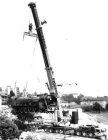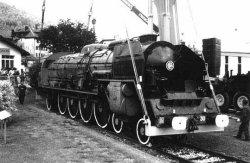




S.N.C.F. 4 8 2, 241 P 1 to 35(*) (1948-1952): Improved version of the 241 C 1 of the P.L.M (herself being a redesigned 241 A 1 of 1925). Impressive but handicaped by insufficient rigidity of chassis resulting in frequent driving axles boxes overheat and boiler fractures, overheat on bissel boxes resulting of the location of the ashcan, VERY difficult maintenance.
According to the internal documents from the D.E.L. that I own, the efforts measured with strain gauges on the points of the boiler where the cracks occured were of up to 8 kg / sq.mm. for a maximum resistance of 5 kg / sq.mm. when the machines passed on points. Instead to begin works of rigidification of the chassis which would have required a quasi-complete dismantling of the locomotives, it was chosen to put welded brackets inside the boilers to increase the resistance of the locations affected to a minimum of 12 kg / sq.mm at least.
Chapelon was horrified by these locomotives which constituted the absolute negation from its whole work, especially since in the time when their construction was decided, 242 A 1 had more that given proofs of her excellency, developing almost 2,000 horses more than a 241 P by using a boiler of similar dimension, with a consumption of coal 20 % lower and a reliability without defect.
The reasons having led the leaders of the railroads recently nationalized to make this decision strictly have nothing to do with the technology nor with the railway transport but more with the hostilities that the success allied to a strong personality can entice.
These hostilities raised the worst problems to André Chapelon by the end of the second world war, I hope to have the opportunity to develop this aspect of the problem soon. Indeed, it is only in the light of these too little known elements that we can understand the very premature withdrawal of the 240 A and especially P series, as well as the absence of building of series following the tremendous prototypes 242 A 1, 141 E 113, 160 A 1 and 140 J 148.
Curiously, the 241 P were the last steam engines for express services to be removed from the service... Or can be it it was perfectly logical on the contrary, on one hand because of what precedes and on the other hand because the management of the S.N.C.F. was apparently decided to demonstrate up to the end that the costs of maintenance and exploitation of compound locomotives was definitively higher than those of the s.e. locomotives and also to justify the order of 1340 Mikado which had made so much good for the purses of the North American manufacturers...
About the compared costs of maintenance of the 241 Ps with those of Chapelon machines with poppet valves, I remind the results recorded during comparative tests organized on his network by Mr. Jean Lancrenon, chief engineer of the company of the North and which highlight that, I quote again: "... The number of hours of ordinary maintenance required by these machines during the period of tests had been of 16 hours for Chapelon's 3715, 35 hours for 3.1289, 55.6 hours for 241-003 and 80.8 hours for the 241 C 1. " 241 C 1 which is thus the prototype of the 241 P series...
There are so few remaining French compound locomotives today that it is however pleasant that three of these good-looking machines are saved, one of them recently by the Swiss T.M.C., 241 P 30; She had until then been used as "jar of flower machine" in the town of Vallorbe. She was at last rescued by the V.V.T. (Vapeur Val-de-Travers) in 2003, which does not envisage at the moment its restoration but introduce it in detail on its site. The second unit - P 9 - is in the hands of a tourist railway, the Railway of Guitres, which possesses an interesting website introducing among others 241 P 9.
Finally, 241 P 17 who had initially been returned to her
builder le Creusot by the S.N.C.F. for obscure reasons and which would
be at present in the course of restoration by an association to the members
of which I wish a lot of pleasure - being used to operations of heavy industrial
maintenance - as well as to have the big necessary financial backup!
 |
 |
|
| In the depot of Paris la Chapelle, February 58. Photo Fénino. | ||
 |
||
| 241 P 24 in the dépot of Clermont-Ferrand, june 1962. | ||
 |
 |
|
|
|
||
Thanks to Mr. Laurent Voisin of the V.V.T. to have
reminded me that the series was constituted of 35 machines instead of the
30 units originally stated here.